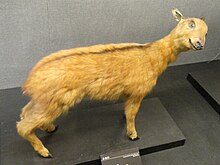Naemorhedus baileyi
| Red goral | |
|---|---|
 |
|
| Scientific classification | |
| Kingdom: | Animalia |
| Phylum: | Chordata |
| Class: | Mammalia |
| Order: | Artiodactyla |
| Family: | Bovidae |
| Subfamily: | Caprinae |
| Genus: | Naemorhedus |
| Species: | N. baileyi |
| Binomial name | |
|
Naemorhedus baileyi Pocock, 1914 |
|
The red goral (Naemorhedus baileyi) is a species of even-toed ungulate in the subfamily Caprinae in the family Bovidae. It is found in India, Tibet and Myanmar. Its natural habitats are seasonal mountainous areas 1,000 to 2,000 meters above sea level. It is threatened by habitat loss and hunting.
The genus name Naemorhedus is derived from the Latin words nemus (genitive nemoris), meaning "forest", and haedus, meaning a young goat.
Reports dating back to 1912 of a remarkable foxy-red coloured goral or goat-antelope (Nemorhaedus) from S.E. Tibet and N.E. Assam have been investigated.
One of the earliest recorded references to their existence was made in 1863, however it was not until 1961 that the red goral was identified as its one species.
Red goral are endemic to the region where the borders of India, Myanmar, and China meet.
The red goral is a bright foxy-red animal with long, soft, shaggy hair. A thin, dark stripe runs along the back from the head to the tip of the tail. The legs are the same rich red as the body, while the undersides are a lighter buff color. The black-colored tail is very short for a goral, but a long tuft of dark hair at the end may double its apparent length.
The red goral is easily distinguished from other members of the genus Naemorhedus by its reddish coat - all other gorals are greyish-brown with grizzled hairs. The red goral is also the smallest goral, and has a greater curvature to its horns. Both males and females have a pair of short, arcing horns. The horns of males tend to be longer and thicker than those of females, but lengths of 7.5–16 cm are typical for both sexes.
Body weight of the red goral typically ranges from 20-30 kilograms. The red goral's body length can reach lengths of 100 cm. There is evidence showing that the females can reach body sizes larger than that of male red gorals, but size difference between the sexes is too small to be significant.
Red gorals are most active during the day, and tend to retreat to inaccessible cliffs at night, where they sleep on sheltered ledges. They are strong climbers and jumpers, and seek safety from predators by fleeing up cliffs. The predators of the red goral are jackals and leopards. They are also very vulnerable and can easily contract Ixodes which is a tick that attacks the tissue and then sucks the gorals blood. They can clear obstacles over 1.8 m high from a standing start. Red gorals live in mountainous regions and woodlands in The People’s Republic of China and other countries near China. The goral is an animal that migrates vertically according what season it is. During the summer seasons they stay in the upper area of the forest while during the winters they migrate down to the low areas in the forest. Although generally quiet, males make a call which sounds like "zer - zer" during the breeding season; female red gorals also whistle as males approach. Red gorals typically inhabit a home range of around 40 hectares. Males are territorial during the breeding season. Their diets consist of lichens, grasses, stems, and leaves. Their most common food source is Usnea which is a type of lichen.
...
Wikipedia

